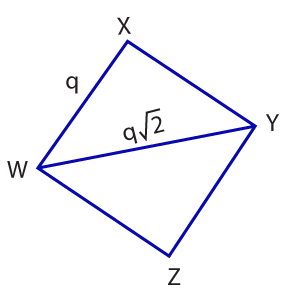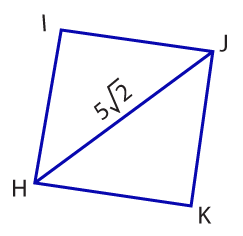At this point, you know that a parallelogram is a rhombus if at least two consecutive sides are congruent. How can you use this postulate to solve problems? Check out the tab set below to find out. In the first tab, practice proving that a parallelogram is a rhombus if it has two consecutive congruent sides. Use the other tabs to apply this postulate.
Proof
Problem 1
Problem 2

In parallelogram EFGH, GH \(\small\mathsf{\cong}\) EH. Prove EFGH is a rhombus.
|
By the transitive property,
EF \(\small\mathsf{\cong}\) FG \(\small\mathsf{\cong}\) GH \(\small\mathsf{\cong}\) EH. Because all four sides are congruent, parallelogram EFGH is a rhombus.
By definition of parallelogram, opposites sides are congruent. Therefore, GH \(\small\mathsf{\cong}\) FE.
Also, by definition of parallelogram,
EH \(\small\mathsf{\cong}\) FG. |
1
2
3
4
|
In parallelogram WXYZ, side WX has length q and diagonal WY has length q\(\small\mathsf{\sqrt{2}}\). Show that WXYZ is a rhombus. Answer the following questions to solve this problem.

| Using the Pythagorean Theorem, what is the length of side XY? | XY = \(\small\mathsf{\sqrt{WY^2 - WX^2}}\) XY = \(\small\mathsf{\sqrt{2q^2 - q^2}}\) XY = \(\small\mathsf{\sqrt{q^2}}\) XY = q |
| You see that XY = q. What is the length of consecutive side WX? | WX = q |
| Since two consecutive sides are congruent, what do you know about parallelogram WXYZ? | WXYZ is a rhombus |
The diagonal of rhombus HIJK is 5\(\small\mathsf{\sqrt{2}}\). What is the perimeter of HIJK? Answer the following questions to solve this problem.

| Because HIJK is a rhombus, what do you know about the lengths of consecutive sides HI and IJ? | HI = IJ |
| Since you don't know the lengths, assign an unknown variable, x, to each side. Using the Pythagorean theorem, what is the value of x? | 5\(\small\mathsf{\sqrt{2}}\) = \(\small\mathsf{\sqrt{x^2 + x^2}}\) 5\(\small\mathsf{\sqrt{2}}\) = \(\small\mathsf{\sqrt{2x^2}}\) 5\(\small\mathsf{\sqrt{2}}\) = x\(\small\mathsf{\sqrt{2}}\) 5 = x |
| Since the length of one side is 5, what is the length of its consecutive side? | HI = IJ = 5 |
| Using the definition of rhombus, what is the length of the other sides? | HI = IJ = JK = HK = 5 |
| What is the perimeter of HIJK? | perimeter = (4)(5) = 20 |
